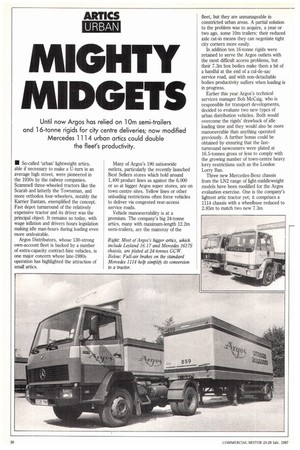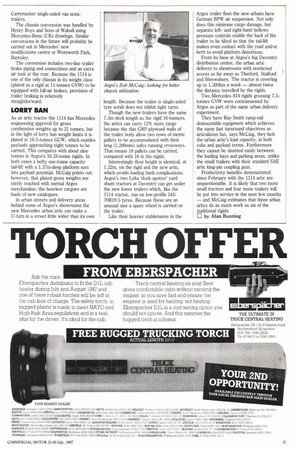MIGHTY MIDGETS
Page 32

Page 33

If you've noticed an error in this article please click here to report it so we can fix it.
Until now Argos has relied on 10m semi-trailers and 16-tonne rigids for city centre deliveries; now modified Mercedes 1114 urban artics could double the fleet's productivity.
• So-called 'urban lightweight artics, able if necessary to make a U-turn in an average high street, were pioneered in the 1930s by the railway companies. Scarnmell three-wheeled tractors like the Scarab and latterly the Townsman, and more orthodox four-wheelers, notably the Karrier Bantam, exemplified the concept. Fast depot turnaround of the relatively expensive tractor and its driver was the principal object. It remains so today, with wage inflation and drivers hours legislation making idle man-hours during loading even more undesirable.
Argos Distributors, whose 130-strong own-account fleet is backed by a number of extra-capacity contract-hire vehicles, is one major concern whose late-1980s operation has highlighted the attraction of small artics. Many of Argos's 190 nationwide outlets, particularly the recently launched Best Sellers stores which hold around 1,400 product lines as against the 6,000 or so at bigger Argos super stores, are on town centre sites. Yellow lines or other unloading restrictions often force vehicles to deliver via congested rear-access service roads.
Vehicle manoeuvrability is at a premium. The company's big 24-tonne artics, many with maximum-length 12.2m semi-trailers, are the mainstay of the fleet, but they are unmanageable in constricted urban areas. A partial solution to the problem was to acquire, a year or two ago, some 10m trailers; their reduced axle cut-in means they can negotiate tight city corners more easily.
In addition ten 16-tonne rigids were retained to serve the Argos outlets with the most difficult access problems, but their 7.3m box bodies make them a bit of a handful at the end of a cul-de-sac service road, and with non-detachable bodies productivity suffers when loading is in progress.
Earlier this year Argos's technical services manager Bob McCaig, who is responsible for transport developments, decided to evaluate two new types of urban distribution vehicles. Both would overcome the rigids' drawback of idle loading time and they would also be more manoeuvrable than anything operated previously. A further bonus could be obtained by ensuring that the fastturnround newcomers were plated at 16.5-tonnes gross or less to comply with the growing number of town-centre heavy lorry restrictions such as the London Lorry Ban.
Three new Mercedes-Benz chassis from the LN2 range of light-middleweight models have been modified for the Argos evaluation exercise. One is the company's lightest artic tractor yet; it comprises a 1114 chassis with a wheelbase reduced to 2.85m to match two new 7.3m Carrymaster single-axled van semitrailers.
The chassis conversion was handled by Henry Boys and Sons of Walsall using Mercedes-Benz (UK) drawings. Similar conversions in the future will probably be carried out in Mercedes' new modifications centre at Wentworth Park, Barnsley.
The conversion includes two-line trailer brake piping and connections and an extra air tank at the rear. Because the 1114 is one of the only chassis in its weight class (plated as a rigid at 11-tonnes GVW) to be equipped with full-air brakes, provision of trailer braking is relatively straightforward.
LORRY BAN
As an attic tractor the 1114 has Mercedes engineering approval for gross combination weights up to 21 tonnes, but in the light of lorry ban weight limits it is plated at 16.5-tonnes GCW, which enables payloads approaching eight tonnes to be carried. This compares with about nine tonnes in Argos's 16.25-tonne rigids. In both cases a hefty one-tonne capacity tail-lift with a 1.37m-deep platform eats into payload potential. McCaig points out, however, that plated gross weights are rarely reached with normal Argos merchandise; the heaviest cargoes are loads of new catalogues.
In urban streets and delivery areas behind some of Argos's showrooms the new Mercedes urban artic can make a U-turn in a street little wider than its own length. Because the trailer is single-a)ded tyre scrub does not inhibit tight turns.
Though the new trailers have the same 7.3m deck length as the rigid 16-tonners, the artics can carry 12% more cargo because the thin GRP-plywood walls of the trailer body allow two rows of metric pallets to be accommodated with their long (1,200mm) sides running crossways. That means 18 pallets can be carried, compared with 16 in the rigids.
Interestingly floor height is identical, at 1.22m, on the rigid and the new artic, which avoids loading bank complications. Argos's two Lyka 'dock-spotter' yard shunt tractors at Daventry can get under the new lower trailers which, like the 1114 tractor, run on low-profile 245/ 70R19.5 tyres. Because these are an unusual size a spare wheel is carried on the trailer.
Like their heavier stablemates in the Argos trailer fleet the new urbans have German BPW air suspension. Not only does this minimise cargo damage, but separate leftand right-hand bellows pressure controls enable the back of the trailer to be tilted so that the tail-lift makes even contact with the road and/or kerb to avoid platform distortions.
From its base at Argos's big Daventry distribution centre, the urban artic delivers to showrooms with restricted access as far away as Thetford, Stafford and Shrewsbury. The tractor is covering up to 1,300km a week — almost twice the distance travelled by the rigids.
Two Mercedes 814 rigids grossing 7.5tonnes GVW were commissioned by Argos as part of the same urban delivery experiment.
They have Ray Smith tamp-rail demountable equipment which achieves the same fast turnround objectives as articulation but, says McCaig, they lack the urban artic's load capacity, in both cube and payload terms. Furthermore they cannot be shunted easily between the loading bays and parking areas, unlike the small trailers with their standard SAE artic king-pin coupling gear.
Productivity benefits demonstrated since February with the 1114 artic are unquestionable. It is likely that two more small tractors and four more trailers will be put into service in the next few months — and McCaig estimates that three urban artics do as much work as six of the traditional rigids.
by Alan Bunting




















































































